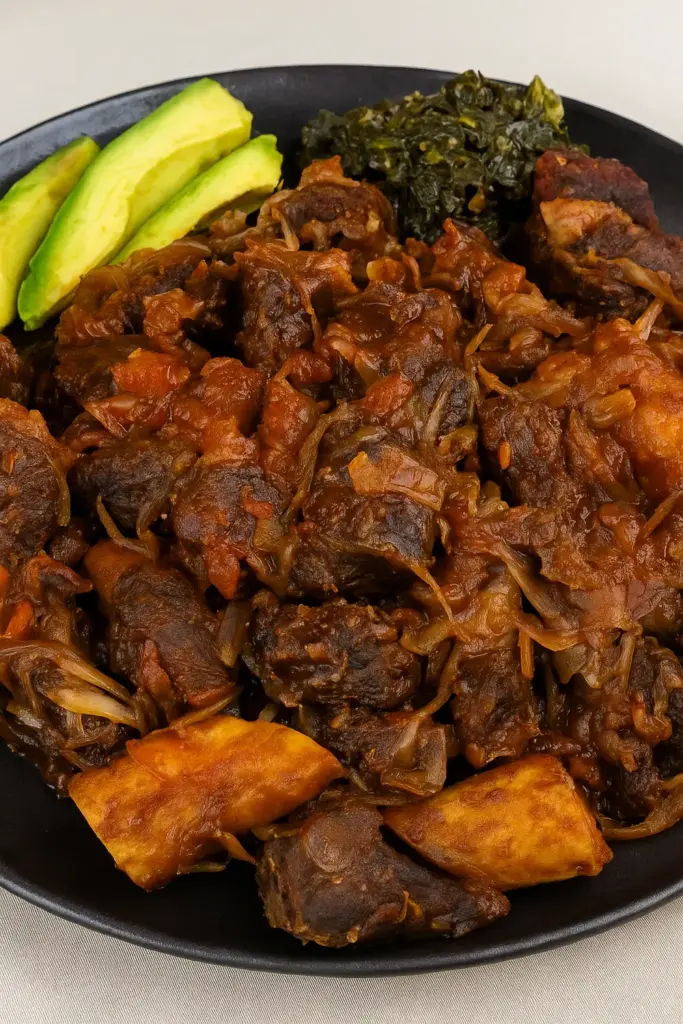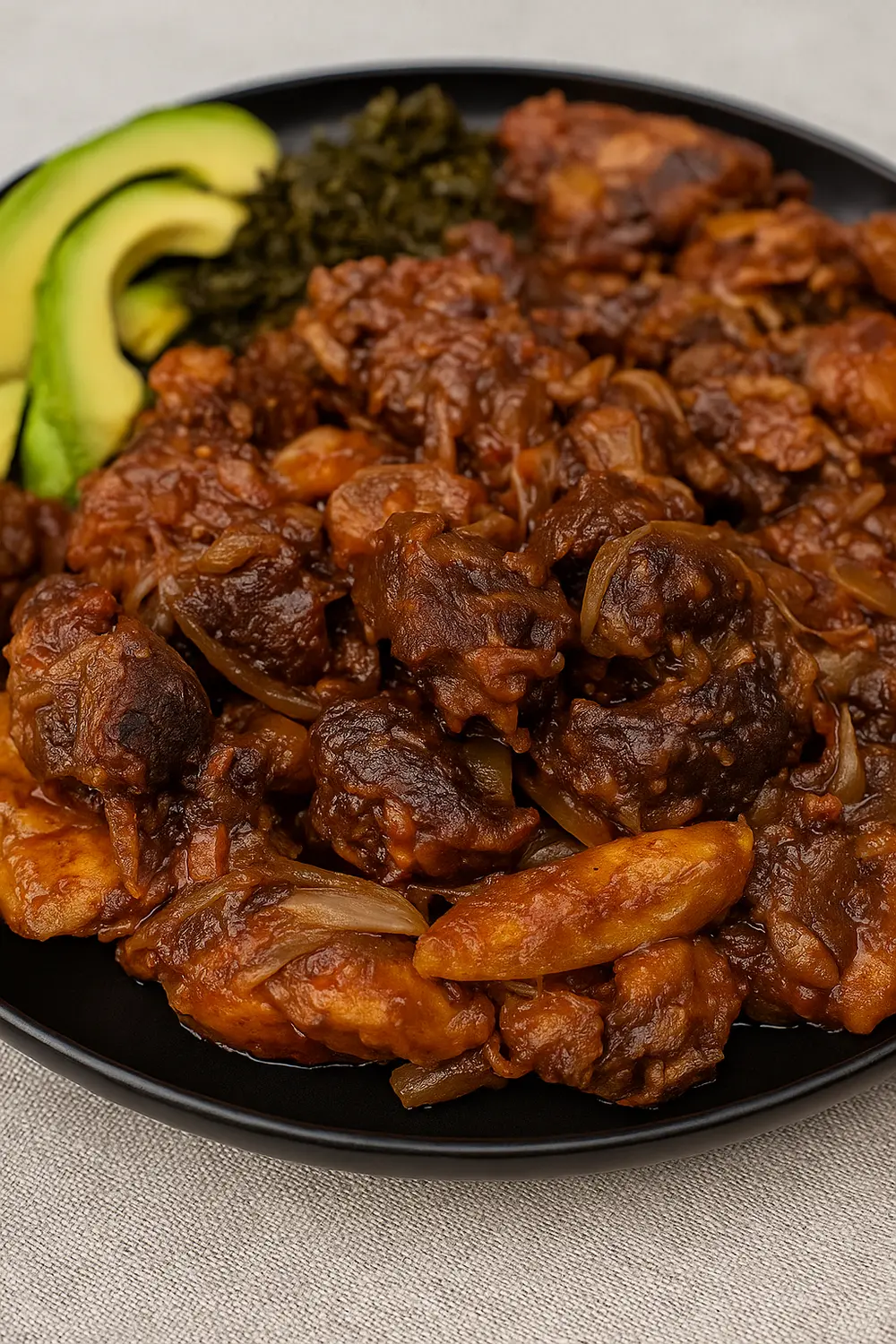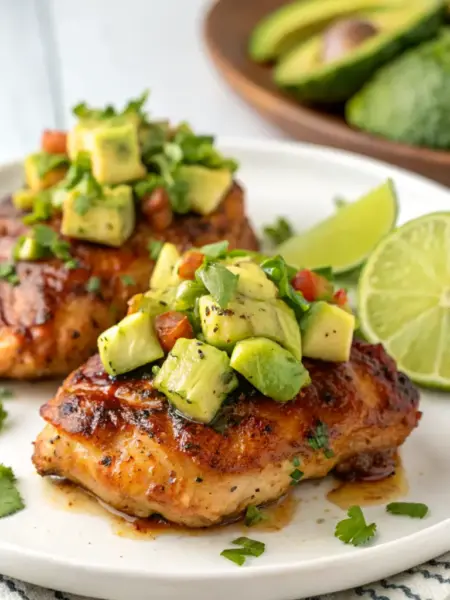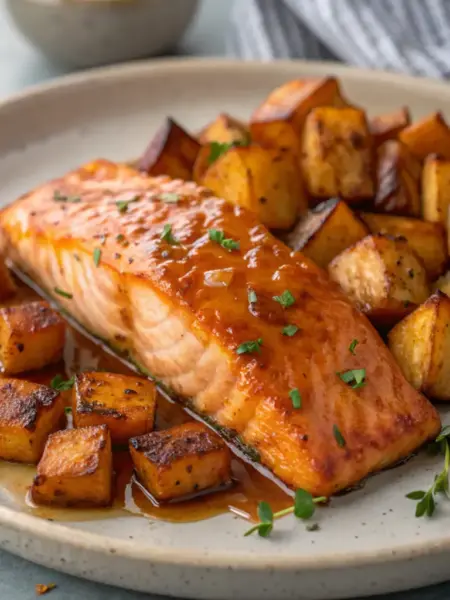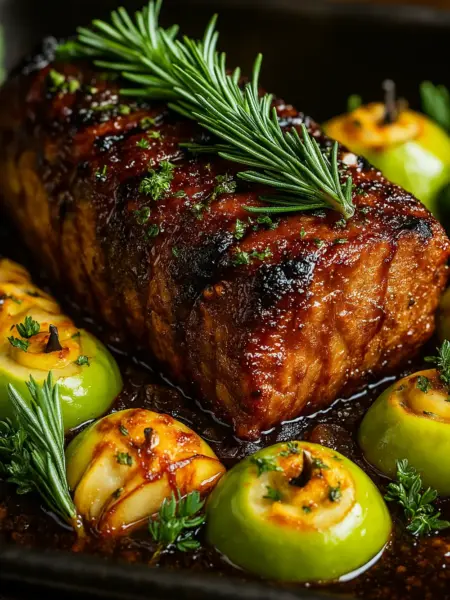This post may contain affiliate links, meaning I may earn a commission if you make a purchase, at no extra cost to you. I only recommend products I trust. Thank you for your support.
If you’ve ever been lucky enough to taste a truly home-cooked dish from Uganda, you know how the food there is often delicious and fresh.
This Ugandan pork stir fry recipe features crispy pan-fried pork with tomatoes and onions, then served with traditional fried matooke (cooked green bananas), fresh avocado, and a refreshing tomato and onion kachumbari salad.
Originally consumed by specific communities due to cultural and religious reasons, pork has gained widespread acceptance across Uganda, with Kikalayi pork emerging as a preferred dish for its robust, satisfying flavor.
Kikalayi pork gets its name from kalayi, meaning “wok,” which is commonly used to prepare pork stir fry dishes in Uganda.
Matooke, made from green bananas, can be tricky to peel and is high in carbs, so if you’re aiming for a low carb meal, you can skip it or substitute it with another side.
This pork stir fry recipe serves six, is easy to make, and is traditionally enjoyed from one large tray, with everyone gathered around to share.
It’s a perfect dish for gatherings, especially during football matches, most famously the English Premier League, which is hugely popular in Uganda.
For this recipe, you can either use pork shoulder for the best texture, pork belly for extra richness (though it cooks more slowly), or pork tenderloin for quicker cooking, but it can dry out easily.
✅ Take a moment to read through the whole post for the ingredient list, expert tips, and equipment suggestions. The full recipe is right below!
Key Ingredients for This Ugandan Pork Stir Fry Recipe
Here are the key ingredients you will need for this Ugandan kikalayi pork recipe:
1. Pork
- Pork belly is ideal for this fried pork recipe because its fat content adds extra richness and a silky texture, creating the deep, savory mouthfeel that defines the dish.
- Pork shoulder has a good balance of meat and fat that fat melts with slow cooking and keeps the pieces juicy while the exterior crisps when pan-fried.
- Pork tenderloin is leaner and cooks fast, use it if you want less fat, but reduce simmering time to avoid dryness.
2. Matooke
- Matooke is a traditional Ugandan staple that’s soft, subtly starchy, and a little earthy. It’s the perfect neutral, comforting base to absorb the pork sauce.
- If matooke isn’t available, plantains, boiled cassava, roasted yams, boiled potatoes, or rice are all good choices.
3. Tomatoes & Onions
- These two ingredients form the flavorful base of the sauce, providing a rich, savory, and umami taste.
- When cooked properly, the tomatoes break down and the onions caramelize, forming a thick, clinging sauce that coats the pork.
4. Fresh Avocado
- Fresh avocado slices add a cool, creamy element that beautifully counterbalances the heat and spice, ensuring that every bite remains refreshing and well-rounded.
- Use just-ripe avocados, soft but not mushy.
5. Royco
- This is a well-known East African seasoning blend.
- It is a bouillon mix made from sun-dried herbs and spices that adds a deep, savory, and beefy flavor to the pork stir fry, which is integral to the authentic taste of the dish.
6. Cabbage
- Adding shredded cabbage introduces a delightful crunch and extra volume to Ugandan pork stir fry dishes.
- Napa or green cabbage both work.
7. Greens
- Greens such as sukuma wiki, collards, and spinach add earthy bitterness, color, and nutrients, and help round out the plate.
- Swiss chard or kale are suitable alternatives.
8. Kachumbari
- This is a fresh salad made with tomatoes, onions, and lime juice.
- It is not just a side dish but a vital component that provides a necessary acidic and crunchy contrast to the rich, heavy flavors of the fried pork.
9. Curry Powder
- East African curry powder is a fragrant blend of spices such as coriander, turmeric, cumin, fenugreek, cardamom, cloves, and cinnamon, giving dishes like Kikalayi pork their warm, savory depth.
- Simba mbili is mainly used, but Garam masala or a mild Madras blend can work as an alternative.
10. Neutral Oil
- Use high smoke point neutral oils like sunflower, vegetable, canola, or peanut oil.
- Cooking oil is used for frying the pork and matooke at high heat.
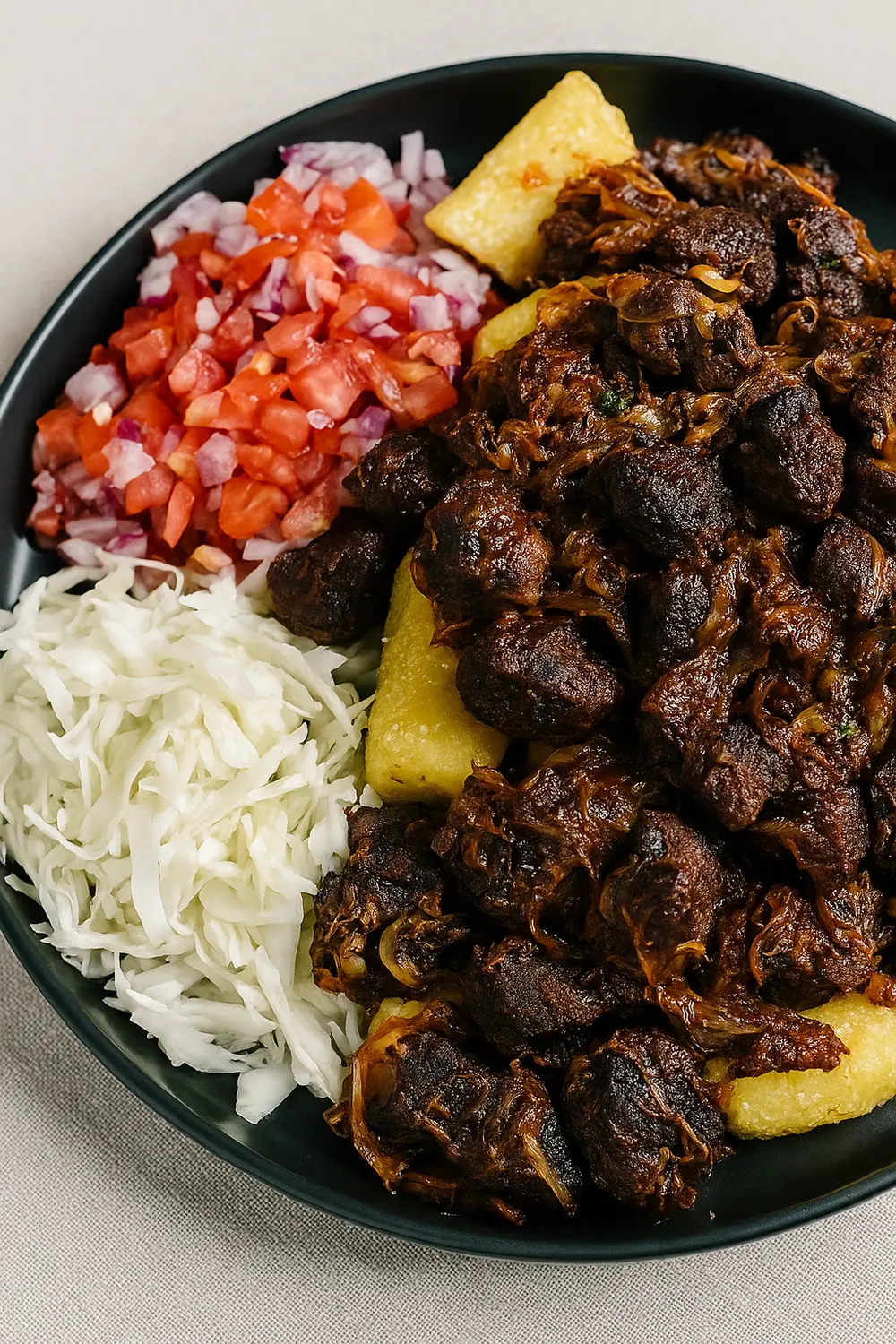
Essential Kitchen Tools Needed for Kikalayi Pork
Check out our shop for top-rated, expert-recommended kitchen equipment:
- Wok (kalayi) or Large Skillet: A wok is ideal for its even heat distribution and ability to handle high-temperature stir-frying, but a large heavy-bottomed skillet works just as well.
- Cutting Board & Sharp Knife: A sturdy cutting board and sharp knife ensure precise, uniform cuts of pork and vegetables for even cooking.
- Mixing Bowls: Used for washing greens, preparing kachumbari, and mixing spices with other ingredients.
- Long-Handled Stainless Steel Tongs: These let you safely turn pork pieces while frying and lift food out of hot oil without splashing.
- Wooden Spoon or Metal Spatula: A wooden spoon is gentle on the wok, and a metal spatula is great for scraping fond in stainless steel pans.
- Measuring Spoons: Accurate measurements of spices and liquids guarantee consistency in flavor every time you prepare the dish.
- Colander: Useful for washing and draining the greens and keeps produce from sitting in dirty water.
- Ladle: Useful for safely scooping out most of the hot oil from the wok into a heatproof container without spilling.
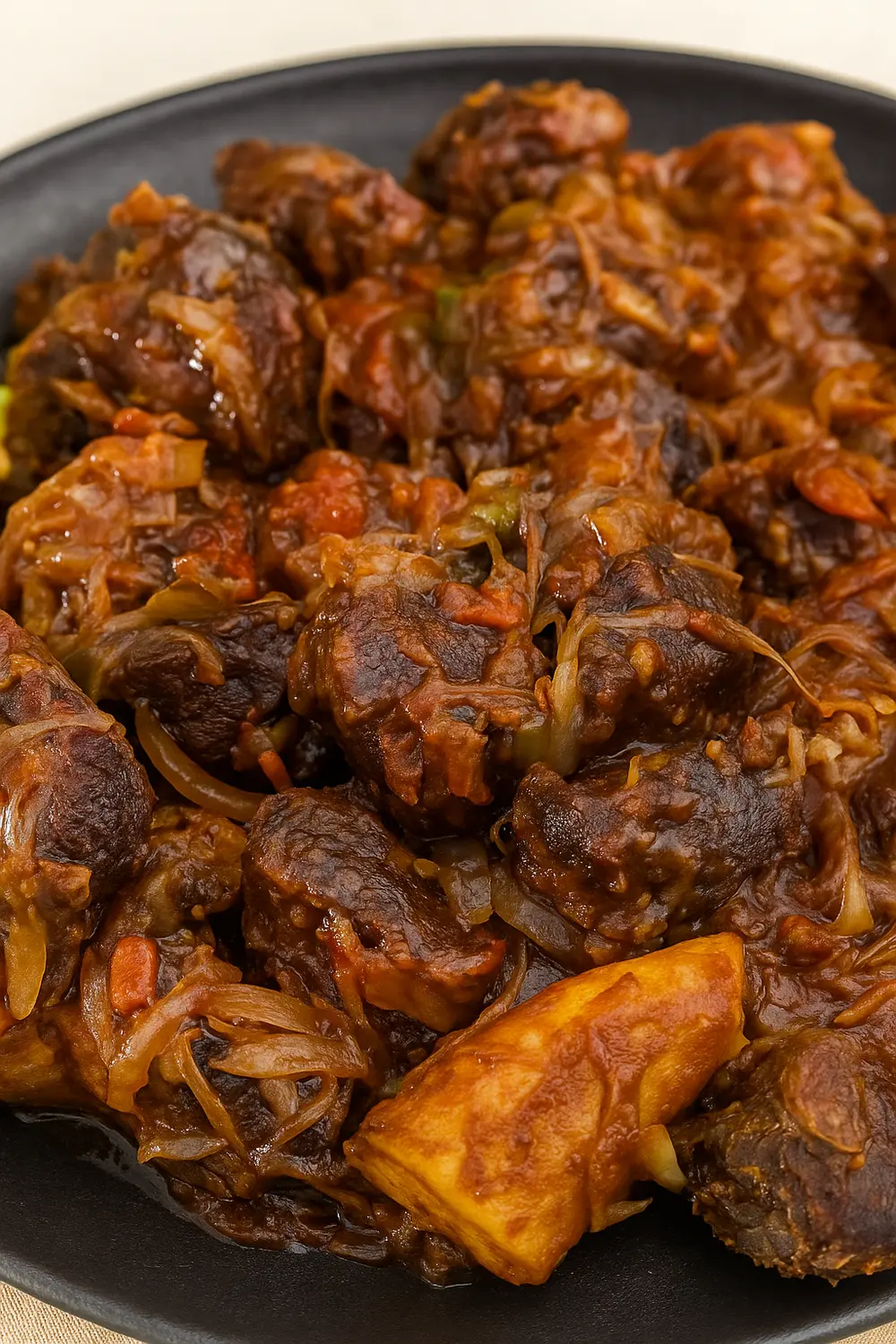
Why You’ll Love This Ugandan Fried Pork
Kikalayi pork is not only flavorful but also comes with several nutritional benefits:
- High Protein Content: Pork is a high-quality protein that provides all the essential amino acids needed for muscle repair and lasting fullness.
- Rich in B vitamins: Kikalayi pork is especially high in thiamine, niacin, and B12, which support energy metabolism, brain and nerve function, and healthy red blood cell production.
- Source of Iron: Pork contains easily absorbed heme iron, which helps prevent tiredness and supports steady oxygen delivery throughout the body.
- High in Zinc: A good source of zinc, pork strengthens the immune system, aids wound healing, and supports normal growth and development.
- Fiber from Sides: Served with matooke, cabbage, and kachumbari, this dish provides dietary fiber that supports digestion and keeps you satisfied.
- Healthy Fats: Pork belly and shoulder add richness and help absorb vitamins A, D, E, and K, while avocado provides heart-healthy fats that support cholesterol and heart health.
- Balanced Meal: With protein-rich pork, fiber-filled vegetables, and energy-giving carbs from matooke, Kikalayi pork is both hearty and nourishing.
- Anti-Inflammatory Benefits: Fresh vegetables like tomatoes, onions, cabbage, and avocado, along with spices in curry powder, provide antioxidants and compounds that help reduce inflammation and support overall health.
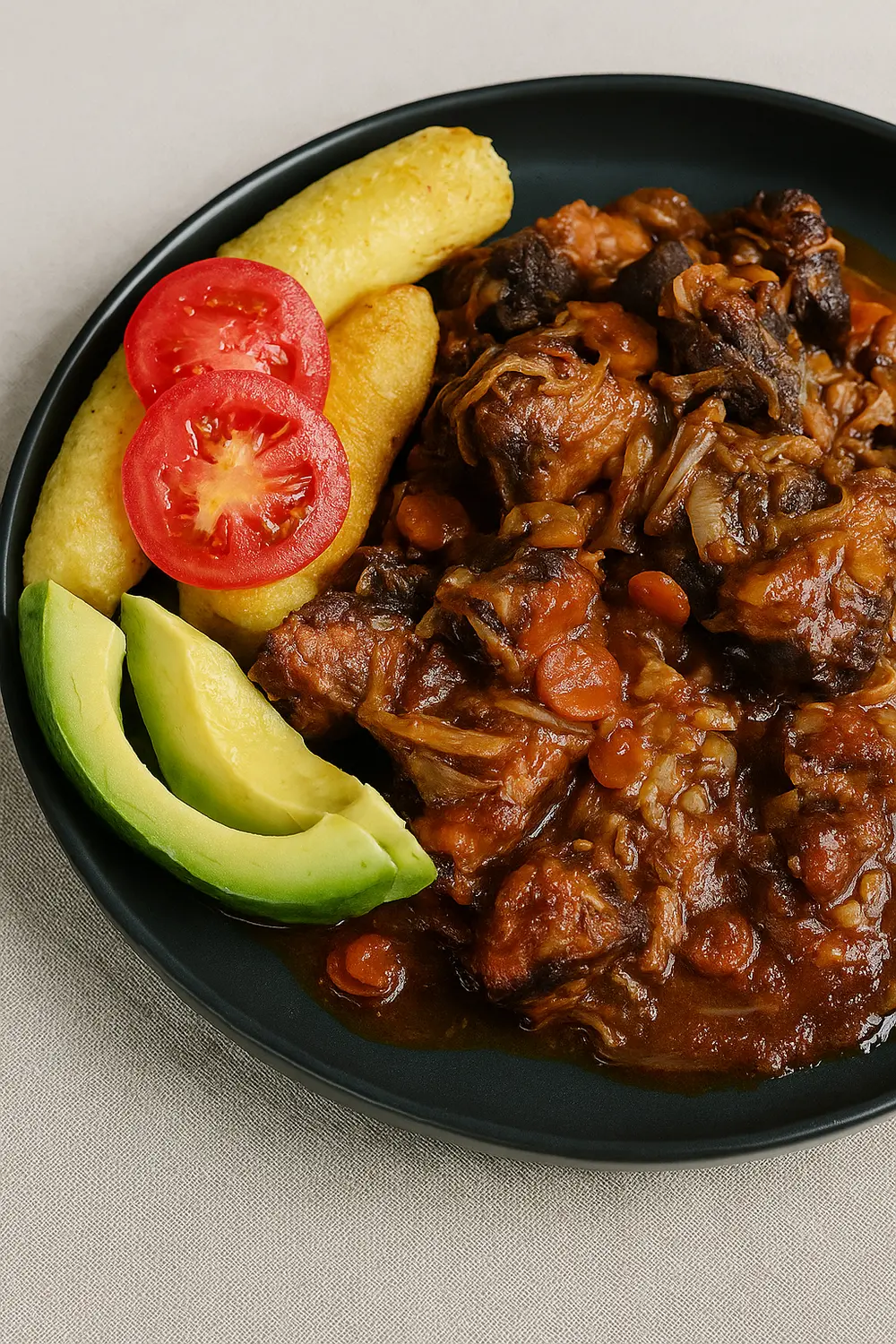
What to Pair with Ugandan Pork Stir Fry Dishes
To complete your East African dining experience, consider these traditional pairings:
1. Matooke
- A staple in Ugandan cuisine, matooke consists of steamed and mashed green bananas.
- Its soft, starchy texture is perfect for soaking up the rich, spicy sauce of the pork stir fry, adding a mildly sweet contrast to the savory flavors.
2. Roasted Cassava Fries
- Cassava, with its natural earthy flavor, when roasted into crispy fries, adds a delightful crunch.
- It’s a wonderful alternative to regular fries, giving a nod to local ingredients and offering a satisfying carbohydrate boost.
3. Fried or Grilled Plantain
- Ripe plantains, with their subtle sweetness, are excellent when fried or grilled.
- Their soft interior and crispy exterior complement the spicy pork, balancing heat with a touch of sweetness.
4. Ugali or Posho
- This traditional East African staple food also known as posho serves as a hearty side.
- Its neutral flavor provides a canvas that lets the bold flavors of the stir-fry shine while adding a comforting, filling element to the meal.
5. Roasted Sweet Potato Fries
- For those who enjoy a mix of sweet and savory, roasted sweet potato fries bring an extra layer of complexity.
- Their natural sweetness contrasts beautifully with the spicy pork, making every bite a symphony of flavors.
Tips for Making the Best Ugandan Pork Stir Fry
These pro tips will help you bring out that authentic Ugandan flavor while keeping the dish balanced, wholesome, and truly satisfying:
1. Fry in Batches
Always cook the pork in batches so each piece has enough space to caramelize. Overcrowding the pan lowers the heat, causing the meat to steam instead of frying, which prevents that rich golden crust.
2. Pour Off Excess Oil
After frying, drain or pour off most of the oil, leaving just enough to sauté onions, garlic, or other aromatics. This keeps the stir-fry flavorful without turning greasy, while still carrying the pork’s savory richness.
3. Peel Matooke with Care
Matooke (green bananas) can be tough to peel, so cut off the tips, slice along the skin, and use a knife or thumb to gently pry it off. Rubbing your hands with a little oil before peeling helps reduce stickiness from the sap.
4. Don’t Mash the Matooke
Handle matooke gently to keep the pieces whole and intact. Frying them briefly first gives a sturdier exterior, and folding them in carefully later prevents mashing.
5. Slice the Avocado Last
Cut the avocado just before serving to keep it fresh and vibrant. A quick drizzle of lime or lemon juice prevents browning and adds a zesty touch.
6. Keep Kachumbari Crisp
Prepare and dress the tomato-onion kachumbari salad at the very end so it stays crunchy and refreshing, balancing the richness of the pork.
7. Hold on Low Heat
Once the pork, cabbage, and matooke are combined, keep the wok over low heat until serving. This keeps everything warm while allowing the flavors to meld together.
Final Thoughts
With tender fried pork, fragrant spices, and an irresistible smoky-charred flavor, this Kikalyi Pork recipe captures the essence of a true Ugandan street-food classic.
Pair it with a simple tomato-onion salad, roasted plantains, or a side of chapati for an authentic Ugandan feast that will transport you straight to the bustling food stalls.
If you give this recipe a try, we’d love to hear how yours turned out. Share your version or leave your thoughts in the comments below.
You’ll find the full recipe with step-by-step cooking instructions just below.
Best Ugandan Pork Stir Fry (Kikalayi Pork)
This easy Ugandan pork stir fry recipe serves six and features crispy pan-fried pork with tomatoes and onions, then served with traditional fried matooke (cooked green bananas), avocado, and kachumbari salad.
Ingredients
For the Kikalayi Pork
For the Matooke and Sides
For the Kachumbari Salad
Step-By-Step Cooking Instructions
Prep Everything First
- Chop the pork into even bite-size cubes (about 1 to 1½ inches).
- Slice the onions and tomatoes and mince the garlic.
- Slice the bell pepper into strips.
- Shred the cabbage thinly.
- Peel the matooke (green bananas) and leave whole for frying.
- Dice tomatoes and red onion, and slice the fresh red chili for the kachumbari.
Sauté the Greens
- Remove the leaves from the stems and place the leaves in a dish.
- Rinse the greens under cold, running water to remove grit and sand.
- Pour off the wash water and repeat until the water runs clear.
- Shake or spin dry, then cut the greens into small bite-sized pieces.
- Heat a medium saucepan over medium heat.
- Toss in the chopped sukuma wiki (collards) or spinach, then add the sliced onion.
- Add a pinch of salt and toss evenly.
- Cover the pan, and sauté the greens until they are just wilted for about 3 to 5 minutes.
- Remove from heat and keep warm aside.
Heat the Wok
- Put a wok or large skillet on the stove and pour in about 2 cups neutral oil.
- Adjust the oil depending on the size of your pan.
- Heat over high until the oil shimmers and is hot but not smoking.
Fry the Pork
- Add pork cubes to the hot oil in batches.
- Fry until the pork develops a rich, dark golden crust.
- When browned, lift pork out and set aside.
- Repeat until all the pork is fried.
Fry the Matooke
- Using the same oil in the wok, carefully add the peeled matooke.
- Fry until the surface is lightly golden and a little blistered.
- Then remove and set aside with the pork.
Drain Out the Oil
- Carefully pour out most of the hot oil from the wok into a heatproof container (or use a ladle).
- Leave about 2 tablespoons of oil in the wok to cook the aromatics.
- This prevents the dish from becoming greasy but keeps enough fat to carry flavor.
Brown the Onions
- Place the wok with the reserved oil back on the stove over medium heat.
- Add the sliced onions.
- Cook slowly, stirring occasionally, until the onions are soft and nicely browned.
Add the Tomatoes
- Once the onions are browned and caramelized, add the diced tomatoes to the onions.
- Use your spatula to gently press/squash them as they cook so they break down and release juices.
- Stir until the mixture becomes saucy and the tomato pieces have softened.
Add Garlic and Bell Pepper
- Toss in the minced garlic and bell pepper strips.
- Cook for 1 to 2 minutes until fragrant without burning the garlic.
- The bell pepper should soften but still retain a bit of snap.
Reintroduce the Pork and Matooke
- Return the browned pork cubes to the wok and fold them into the sauce so they pick up the caramelized onion and tomato flavors.
- Stir well to coat each piece.
- Gently nestle the fried matooke chunks back into the pork mixture, tossing carefully so you don’t mash them.
- You want the bananas to stay intact while they soak up some sauce.
Season
- Sprinkle in the curry powder, Royco, paprika (or your chosen ground spice), a pinch of salt, and black pepper.
- Stir to combine.
- Taste and adjust, and add a little more salt if needed.
Add the Shredded Cabbage
- Add the shredded cabbage to the wok and stir gently to combine.
- Cook while stirring gently until the cabbage is tender yet still slightly crisp.
- Be mindful not to mash the matooke while stirring.
- As the cabbage softens, reduce the heat to low and let everything sit for 3 to 5 minutes so the flavors blend.
- Keep the pan on low heat (do not remove it from the stove) until you’re ready to plate.
Make the Kachumbari Salad and Avocado
- While the fried pork finishes, make the kachumbari by combining diced tomatoes, diced red onion, sliced red chili, and a pinch of salt.
- Toss and let the flavors mingle for 2 minutes.
- Cut the avocado into thick wedges, drizzle with lime juice to prevent browning, and set aside.
Plate and Serve
- Spoon the pork, matooke, and cabbage mixture onto a tray or plate.
- Add a generous scoop of kachumbari salad, the sautéed greens, and avocado wedges on the side.
- Serve immediately.
Nutrition Facts
Servings 6
Serving Size 1 heaped cup of pork stir fry
- Amount Per Serving
- Calories 650kcal
- % Daily Value *
- Total Fat 35g54%
- Saturated Fat 11g56%
- Cholesterol 100mg34%
- Sodium 450mg19%
- Potassium 800mg23%
- Total Carbohydrate 45g15%
- Dietary Fiber 10g40%
- Sugars 5g
- Protein 40g80%
- Vitamin A 850 IU
- Vitamin C 75 mg
- Calcium 80 mg
- Iron 3.8 mg
* Percent Daily Values are based on a 2,000 calorie diet. Your daily value may be higher or lower depending on your calorie needs.
Note
- Pork can be relatively high in saturated fat depending on the cut, so choose leaner cuts or trim visible fat to reduce saturated fat intake.
- Maintaining high heat while frying the pork is crucial for quickly caramelizing the pork and locking in juices.
- Commercial seasoning powders (Royco) may be high in sodium, so use low-sodium versions.
- Keep portion sizes of matooke and starchy sides mindful for balanced meals.
- Slice the avocado at the end to prevent it from becoming mushy or browning.

